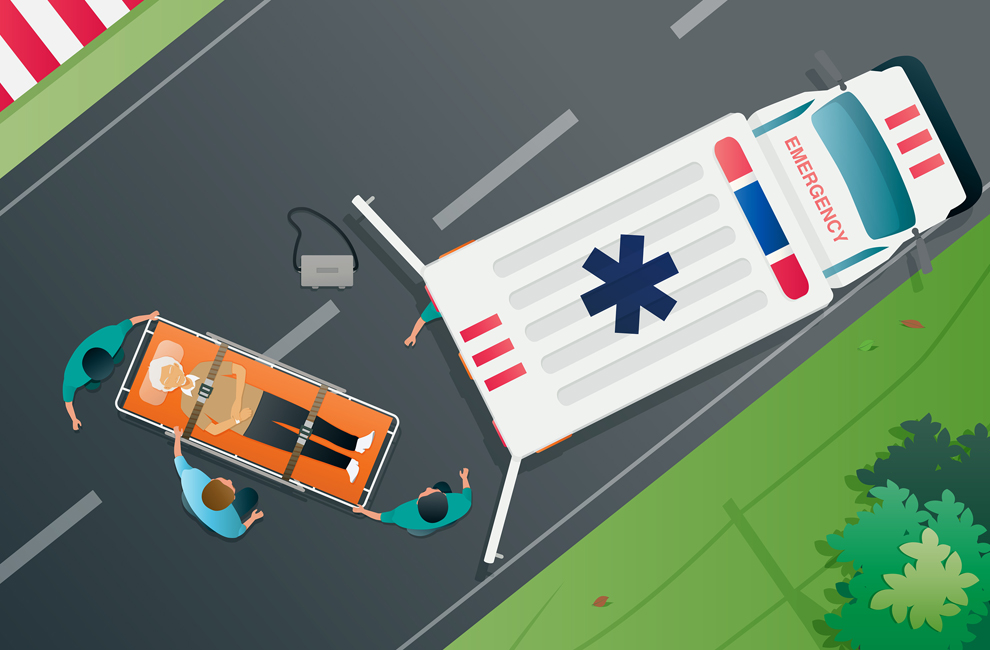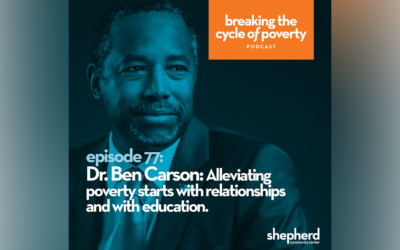This article by Shalom Project team member Shane Hardwick was originally published in the September issue of Fire Engineering magazine.
By Shane Hardwick
I am seldom comfortable with using the words always and never, especially when it comes to public safety or human behavior. Although I cannot speak to the geography or population makeup of every city, I am comfortable assuming that there is an area of your jurisdiction that represents a disproportionate number of calls for emergency medical services (EMS).
Do you ever wonder why this is so? Aside from senior communities, does this area also garner a disproportionate number of police runs as well? It has always been right in front of us, but only recently has it become clear. There are very few areas that are hot spots for crime that don’t also see high EMS call volumes.
It’s not always the case, but what does it look like in your town? The Shalom Project is a joint effort between Shepherd Community Center, Indianapolis EMS, and the Indianapolis Metropolitan Police Department. The mission is to couple beat policing with health care navigation to improve the quality of life in neighborhoods on the east side of Marion County.
Shalom views overuse of 911 as a symptom of an unmet need. The police/medic team builds relationships with the neighbors they encounter on 911 calls, then refers those individuals to Shepherd Community Center.
The community center then steps in and provides social work and advocacy through a host of public and private partnerships. This ultimately leads to reductions in both hospital and jail recidivism.
The neighborhood in which Shalom started is in an area that is no stranger to police, fire, or EMS. The residents that occupy the program’s catchment area faced far darker circumstances than the average Indianapolis citizen. These citizens are statistically 300% more likely to be victims of homicide, have a 400% greater chance of being injured by firearms, and are 300% more likely to suffer from an overdose.
Two-thirds of the homes were either rentals or abandoned, 40% of the population were at or below the poverty line, and single mothers represented the number-one demographic.
It wasn’t until after I started work with the Shalom Project that it occurred to me that police and EMS runs seem to be inexplicably clustered in the same geographic locations, sometimes down to the exact same block. I conducted a very unscientific experiment after I made the connection: I did a side by-side comparison of the zip code in which I work (inner city) and the zip code in which I live (suburbs). I looked at population, income, number of hospitals, doctor’s offices, Level 1 cardiac cath labs, trauma centers, burn centers, pharmacies, ambulances in the district, and number of EMS calls per year.
What I found was remarkable. The population was the same, there was a roughly equal number of primary care options and hospitals, and the same number of ambulances were in service. There was also more access to Level 1 cath and trauma services in the inner-city zip code and several more pharmacies. In addition, there was a $100,000 difference in the average yearly income between work and home.
However, the biggest disparity that I noted was number of calls for EMS. The upper middle-class suburban neighborhood had 1,300 calls for EMS during a calendar year. The inner-city neighborhood, with the same number of citizens with the same (if not better) health care access, called for EMS more than 10,000 times in the same year.
Is this coincidence or is it culture? The world’s population just hit eight billion. Society isn’t getting smaller, and neither are our societal problems. Researchers are now using tools such as Adverse Childhood Experience (ACE) scores and linking them to health outcomes. In addition, social and environmental determinants of health are successfully being used to unlock the mysteries of not only an individual’s longevity but also the well-being of the community at large.
Some of these are the following:
• Safe housing.
• Reliable transportation.
• Violence.
• Education.
• Income.
• Access to food.
What does this have to do with EMS, cardiac arrest outcomes, or crime? In 2018, the Journal of the American Medicine Association published an article that looked at cardiac arrest outcomes in high- vs. low-income areas of the country. The study results stated the following: “The EMS response time to patients in high-income zip codes was more likely to meet 8-minute and 15-minute cutoffs compared with low-income zip codes,” and “Patients with cardiac arrest from the poorest neighborhoods had longer EMS times compared with those from the wealthiest, and response times were less likely to meet national benchmarks in low-income areas, which may lead to increased disparities in prehospital delivery of care over time.”
I was initially unsettled by this article. I felt as if the entire EMS system was being accused of abandoning the poor and huddled masses. We all have our staffing difficulties, but I am going to make another assumption and say that the EMS deployment model in most urban areas has assets clustered in the areas that historically have the highest number of calls. Are the historically high call-volume areas in your town predominantly high or low income?
The big question that the study missed was why was there a delay in response? Is it that the EMS infrastructure wasn’t intact, that it was woefully lacking, or that those valuable resources were unavailable in lower income neighborhoods? Where were the needed resources for the life-and-death emergencies for which we all train?
As the saying goes, “If all you have is a hammer, every problem becomes a nail.” For many cities, systems, and citizens, the only tool in the toolbox is an ambulance.
For cities, if someone is cold, hungry, battling addiction, or suffering from mental health? Call an ambulance. For citizens who don’t have a car, missed a scheduled doctor’s appointment, or ran out of medicine? Call an ambulance.
Fortunately, we now have a study that suggests that EMS is a valuable and finite resource. It’s a resource that if tied up on a nonurgent call can and does have an impact on survivability within the community. Why is this behavior prevalent in low-income areas? According to the U.S. Department of Health and Human Services, “Across the lifespan, residents of impoverished communities are at increased risk for mental illness, chronic disease, higher mortality, and lower life expectancy.”
The question of what’s happening in many neighborhoods can be answered by science. Poverty leads us to pay closest attention to what’s directly in front of us, and we move from one crisis to the next. Can’t make rent? Can’t afford to fix the flat tire? Will the power be disconnected tomorrow? Moving from one issue to the next creates a triage scenario of sorts. This triage pushes people to address the most serious need before moving onto the next most serious need. Who is worried about a primary care appointment scheduled six weeks from now when the patient doesn’t know where his next meal is coming from? And, if he goes to his scheduled appointment, does he have transportation? Does he need to take off work? What about childcare?
This is what leads some to call 911 and using the emergency department for chronic, nonurgent issues right now.
The amygdala is what signals the fight-or-flight response in the brain. Its primary job is processing the emotions and memories associated with fear. Our human ancestors developed this response to deal with threats and dangerous situations. It releases stress hormones that prepare the body to either face the threat or flee from it.
Developmental studies have found that the amygdala is particularly sensitive to stress in early life. High ACE scores or living in a constant state of housing, food, and safety insecurity can have a significant effect on the amygdala and our natural stress response.
Olivia Guy Evans describes an amygdala hijack as, “Useful in some situations that are life-threatening, such as causing us to move out of the way of a car traveling towards us before we have even registered that the car was there. However, in other situations, amygdala hijack can cause us to react in an intense, emotional way which may be out of proportion to the situation.”
This might explain some of the completely irrational things we encounter through the course of our shift. This includes the mother who calls 911 at 3 a.m. for a toddler with a runny nose. However, this can also explain behaviors that have devastating consequences. With sections of the population that are in a constant state of fight or flight because of childhood trauma, chronic environmental issues, or financial insecurity, it becomes easier to see how people can become capable of acts such as murdering someone over a disagreement. A recent study predicted “a 14 percent increase in the violent crime rate for every one percent increase in food insecurity.”
For people who are constantly being driven by their amygdala, there is little attention being drawn to future orientation or consequences that are outside of that moment in time. In addition to the disparity of EMS calls in the two zip codes, I looked at crime statistics as well. The criteria were divided into violent and nonviolent crimes. Violent crimes measures murder, nonnegligent manslaughter, forcible rape, robbery, and aggravated assault. Nonviolent crimes are described as burglary, theft, vehicle theft, and arson. The scoring ranges from 1-100, with one being low and 100 being high.
The results were the following:
• Suburbs (Home): Violent Crime 5.8/ Nonviolent crime 9.5.
• Inner city (Work): Violent crime 81.6/Nonviolent crime 83.0.
• National average: Violent crime 22.7/Nonviolent crime 35.4.
These two geographic locations are not separated by mountains, deserts, or an ocean; they are a 25-minute drive away from each other. They have the same number of citizens and equal health care resources but vastly different statistics. I will ask again, is this coincidence or culture?
For many years, it seems that community policing and community health groups have been unknowingly looking at the same problem but from different vantage points. The factors that have such a big impact on health outcomes such as safe housing, reliable transportation, violence, education, income, and access to food can have a profound impact on other aspects of the individual and the community.
We must understand that if we don’t get a handle on problems ahead of time, we won’t be able to put enough ambulances on the street, add enough seats in the emergency room waiting area, or build jails that are big enough. It’s time to rethink how we care for the citizens we have the honor of serving.
Indianapolis EMS has started tackling the issues that burden not only the EMS system but also the entire community. Programs like the Shalom Project target quality of life and longevity by addressing the social determinants of health. They’ve improved staffing shortages and increased their advanced life support coverage by decoupling paramedics from the ambulance in historically basic life support-heavy districts.
To reduce the calls to the city’s largest homeless mission, they have deployed a fulltime EMS provider to manage chronic conditions and case management from inside the shelter.
Programs like these are what the future of EMS should look like. However, what else can we do? What public or private partnerships can your agency nurture? We can’t legislate our way out of the problem, we probably can’t jail our way out of the issue, and we can’t keep taking the same people to the hospital over and over and being okay with the results.
Building relationships with the people we serve is the key. Coming alongside our neighbors and bridging gaps or helping overcome their barriers— that’s the future of EMS. And the great news is, as EMS agencies, we don’t need to own the whole problem or the solution; there are community groups within your town that want to be part of the solution.
Social fraternities, motorcycle clubs, and the faith-based community are just a few that want to be relevant and engaged. These groups can look very different from each other, but all have the same goal in mind: to help their neighbors.
Building relationships with the people isn’t the responsibility of local, state, or federal governments, but it should be incumbent at the local level of government to identity champions within the community and connect them with those in need.
Shane Hardwick has 29 years of street-level paramedic experience, which includes experience as a SWAT/EOD medic, a DT4EMS instructor, and community paramedic serving in Indianapolis. Shane is a member of Shepherd Community Center’s Shalom Project.




